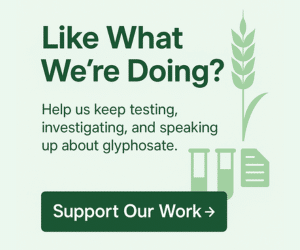When most people think about glyphosate, they think of Roundup and weed control.
But there’s another side to the story—one that’s far more hidden from the average consumer.
Glyphosate is also used to dry down food crops before harvest. It’s sprayed not to control weeds, but to kill the crop itself—on purpose, and on schedule. That’s what’s known as pre-harvest desiccation. And it’s a widespread practice in conventional agriculture.
So while new products like Icafolin are being introduced to “replace” glyphosate for weed control, no one’s talking about what comes next for this side of its use.
Why Is Glyphosate Sprayed Right Before Harvest?
Pre-harvest desiccation is a management tool. By spraying crops like wheat, oats, barley, peas, and canola a few days before harvest, farmers can:
- Force the crop to ripen evenly
- Kill off any green plant matter
- Speed up drying so harvesting can happen sooner
- Avoid losses from weather, pests, or uneven ripening
It’s efficient. It’s predictable. And it creates the kind of uniform harvest that modern supply chains—and global markets—demand.
But it also means glyphosate ends up on food crops just days before they’re processed. That’s how residues end up in bread, cereal, baby food, and even organic-labelled products (through contamination).
If you’ve ever wondered how glyphosate actually gets into our food in the first place, we break that down in more detail here: How Glyphosate Gets Into Our Food.
So… Why Not Just Stop?
Because once glyphosate became the go-to harvest tool, the system began to depend on it. Farmers planted varieties with staggered ripening because they could. Processors began expecting consistent moisture levels. Harvest machinery and storage infrastructure were optimised around chemically assisted timelines.
Take glyphosate out of that picture and you’re no longer tweaking a chemical—you’re disrupting the whole system.
Are There Other Chemicals That Can Replace It?
Some chemical alternatives do exist—but none tick all the boxes:
- Diquat (Reglone®): A contact herbicide used for desiccation in some crops like potatoes. But it’s banned in the EU over safety concerns.
- Carfentrazone-ethyl: Used in pulses, but doesn’t fully desiccate crops and often requires repeat spraying.
- Glufosinate: Another option, but it’s less effective, more expensive, and still comes with toxicity questions.
So far, no chemical has replaced glyphosate in terms of cost, consistency, and efficiency. Which is why, despite all the controversy, it’s still in widespread use.
What About Mechanical or Natural Methods?
There are non-chemical alternatives—but they’re not simple swaps.
- Swathing (cutting the crop and letting it dry in the field) can work well—but it’s labour-intensive and risky in wet climates.
- Natural ripening avoids chemicals completely, but requires patience, the right weather, and varieties bred for uniformity.
- Plant breeding can help—with new crop lines that ripen more evenly or dry down faster—but that takes time and investment, especially in a food system that’s not geared for slow change.
In short: there are alternatives. But they’re slower. More complex. Less appealing to large-scale, chemically dependent operations.
So What Happens Now?
If regulators finally ban pre-harvest glyphosate use—or if enough public pressure forces the industry to act—something will have to give. But right now, there’s no silver-bullet replacement. Which means we’re facing a desiccation dilemma:
Do we keep looking for the next chemical shortcut?
Or do we start redesigning the system so we don’t need one?
Where Does This Leave New Zealand?
Here in New Zealand, pre-harvest glyphosate spraying is still allowed, despite mounting international concerns. And instead of tightening controls, the Ministry for Primary Industries (MPI) is currently proposing to increase the allowable residue limits (MRLs) on some food crops by 9900%.
That means we could see more glyphosate on wheat, oats, and lentils, not less. And most shoppers would never know, because there’s no requirement to disclose whether a crop was desiccated chemically before harvest. No labels. No warnings. Just silent approvals behind closed doors.
But we’re watching. And we think the public deserves to know.
Transparency means more than knowing where our food comes from. It means knowing what’s been sprayed on it—and why it’s still allowed.
A Final Word
Banning glyphosate desiccation won’t fix the system, but it would stop one of the most direct routes for residues to reach our food.
Desiccation isn’t just a harvest technique—it’s a symptom of a bigger problem: a food system that values speed and uniformity over health, biodiversity, and soil integrity.
If we’re going to talk seriously about replacing glyphosate, we have to talk about more than weeds. We have to talk about what we’ve designed this system to do—and whether that’s really what we want anymore.
This article is part of a mini-series exploring what’s replacing glyphosate—and why it might not be the revolution we’re being sold.
- Part 1: Icafolin: The New Glyphosate Alternative or More of the Same?
- Part 2: You are here — The Desiccation Dilemma: Why Glyphosate’s Real Role Is Hard to Replace
- Part 3: What Makes Icafolin Different from Glyphosate?
- Part 4: What Happens After Glyphosate? A System Under Scrutiny
Resources & References
It’s not just about what’s sprayed—it’s about what we’re not being told. These resources shine a light on the hidden role of glyphosate in our food supply and the systemic challenges we face in trying to replace it.
Glyphosate Residue Limits Proposal – Ministry for Primary Industries (MPI), New Zealand
Outlines the proposal to raise allowable glyphosate residues on several food crops in New Zealand. Relevant to concerns about glyphosate desiccation and consumer exposure.
https://www.mpi.govt.nz/consultations/proposed-amendments-to-the-new-zealand-food-notice-maximum-residue-levels-for-agricultural-compounds/
EFSA 2023 Renewal Assessment Report: Glyphosate
The European Food Safety Authority’s latest evaluation of glyphosate’s safety. Includes discussion on residues, environmental fate, and pre-harvest uses.
https://www.efsa.europa.eu/en/topics/topic/glyphosate
Glyphosate in Food: Pre-harvest Use Drives Residue Exposure
Your own investigative article illustrates how pre-harvest glyphosate use contributes to residues in widely consumed food products.
https://nomoreglyphosate.nz/glyphosate-desiccation-harvest-shortcut/
Why Glyphosate Is Sprayed Before Harvest(Ecowatch)
Breaks down historical and modern motivations behind glyphosate desiccation—from speeding up harvest to ensuring uniform ripening.
https://www.ecowatch.com/roundup-cancer-1882187755.html
Glyphosate Desiccation Risks Confirmed in Recent Barley Trial(Safe Food Matters)
Summarizes new research showing that glyphosate residue levels can exceed legal limits even when applied according to label, specifically in malting barley.
https://safefoodmatters.org/2024/09/05/scientists-find-risks-with-preharvest-glyphosate/
What Is Crop Desiccation?(Wikipedia overview with references)
A general primer explaining how crop desiccation works, the difference between contact/desiccant herbicides and systemic ones like glyphosate, and the scope of its use across food crops.
https://en.wikipedia.org/wiki/Crop_desiccation
Why Raising MRLs Threatens Public Health
Explains the potential risks behind MPI’s proposal to raise glyphosate residue limits on food. Contextualizes this issue for a New Zealand audience.
https://nomoreglyphosate.nz/raising-mrls-public-health-risk
The path away from glyphosate isn’t a straight chemical swap—it’s a systems shift. As you explore these sources, ask the bigger question: do we need a new desiccant—or a new approach to food production?
Image Source & Attribution
We’re grateful to the talented photographers and designers whose work enhances our content. The feature image on this page is by IgorStrukov.




